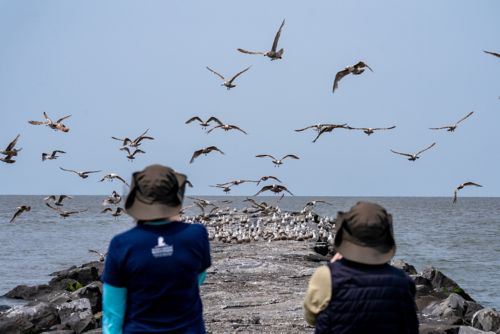St. Jude Family of Websites
Explore our cutting edge research, world-class patient care, career opportunities and more.
St. Jude Children's Research Hospital Home

- Fundraising
St. Jude Family of Websites
Explore our cutting edge research, world-class patient care, career opportunities and more.
St. Jude Children's Research Hospital Home

- Fundraising
St. Jude avian flu hunters’ annual data collection provides context for ongoing pandemic

Jennifer DeBeauchamp-Newman and Pamela McKenzie watch a group of shorebirds take off from a pier on the beach while collecting samples.
When people think of virology, rarely do they think of a week at the beach. However, one of the most consequential long-running virological expeditions traverses the East Coast — from Memphis to Delaware Bay every May — and has for the last 38 years.
This year, this team of virus hunters took to the sand amid an ongoing avian influenza pandemic infecting wild and domestic birds. The current flu pandemic, which began in December 2021, has reportedly affected over 58 million birds across all 50 states in the U.S. and more in countries around the world — making this year’s expedition even more critical.
On the first day of the trip, as the tide began to recede, the researchers lifted their binoculars, looking for signs of their targets. A rich source of virological treasure was soon to arrive. A vast flock of birds, including Red Knots (Calidris canutus), Sanderlings (Calidris alba), Ruddy Turnstones (Arenaria interpres) and Laughing gulls (Leucophaeus atricilla), descended on the beach and began their feast.
They come to this spot along Delaware Bay in search of small, grain-thin greenish eggs present throughout the sand. The birds have traveled across continents for this over-easy buffet. Their migration coincides with the annual egg-laying of the horseshoe crab (Limus polyphemus), drawing hundreds of thousands of birds to feast on eggs on the beach. The scientists methodically follow behind the birds, collecting invaluable samples of bird stool, but more importantly, the viruses within them.
-
Slide activated
St. Jude scientists come to Delaware Bay and look for where horsehoe crabs (Limus polyphemus) are laying their eggs.
-
Slide activated
Once on the beaches, the St. Jude team, (left) Jon (Patrick) Seiler, (right) Jennifer DeBeauchamp-Newman, both of the St. Jude Department of Infectious Diseases, and (center) Pamela McKenzie, St. Jude Global Influenza Research and Surveillance director, look for the groups of birds that have come to feast on the horseshoe crab eggs.
-
Slide activated
A flock of ruddy turnstones (Arenaria interpres) is a promising place to look for influenza positive samples.
-
Slide activated
McKenzie and DeBeauchamp-Newman get their sampling equipment ready.
-
Slide activated
The birds leave easily recognized stool all over the beach. Two collection cotton swabs have been placed into the sand for scale.
-
Slide activated
One of the scientists collects samples with their right hand holding the cotton swab while having multiple tubes between each finger of their left hand to speed the process.
-
Slide activated
Each stool sample is carefully placed and catalogued in a collection tube.
-
Slide activated
Seiler, DeBeauchamp-Newman and McKenzie spread out on the beach, kneeling or squatting while collecting stool samples.
-
Slide activated
The scientists cap tubes and place the collected and catalogued samples into cardboard freezer boxes with 81 spaces for tubes per box. These boxes will later be placed on ice.
-
Slide activated
The scientists head to multiple beaches throughout the week, which are closed during the shorebird migration period. McKenzie walks past a sign warning the beach is closed, as the research group has special permission to be here.
-
Slide activated
DeBeauchamp-Newman and McKenzie watch a large group of horseshoe crabs on a beach just out of the water as the tide goes out.
-
Slide activated
DeBeauchamp-Newman and McKenzie watch a group of shorebirds take off from a pier on the beach while collecting samples.
-
Slide activated
The scientists finish collecting samples on this beach before the tide returns, then reiterate the process several times throughout the week until they have over 1,000 samples.
-
Slide activated
Lisa Kercher, PhD, St. Jude Department of Infectious Disease, packs the boxes full of sample tubes on ice packs in an insulating container. At the end of the week, the scientists will drive these samples back to St. Jude for processing and analysis.
Ripple effects from the past
The trip began decades ago, when Robert G. Webster, PhD, emeritus faculty of the St. Jude Department of Infectious Diseases, discovered the source for all influenza (affecting humans and other animals) was in wild birds. As birds are the natural host of influenza, he planned an annual St. Jude trip to collect samples. Webster needed to identify a place with a high concentration of these animals to ensure flu would be present. He found it in Delaware Bay.
“Delaware Bay is quite a unique environment,” said Richard J Webby, PhD, St. Jude Department of Infectious Diseases, who has continued leading influenza work at the institution since Webster’s retirement. “These shorebirds don’t have a lot of flu in other places around the world, but the ones at Delaware Bay do. It clearly has something to do with the sheer number of birds that go there, the fact they’ve been flying for a long time already, increasing their susceptibility and then spending a long period there that allows viruses to spread quickly.”
Importantly, these bird populations appear to be asymptomatic carriers of the virus, even though they may be infected with a strain known to be dangerous in other types of birds. This resiliency, along with the predictability of their mass migration, make them a near-perfect source of samples to determine what is happening with flu in birds — and provide ever-important context about how the viruses have changed over time and what that might mean for future pandemics, whether in birds or humans. In order to predict what might happen in the future, researchers need to be able to look back at the big picture — data collected over time — to extrapolate trends and anticipate what to expect in the years ahead.
“The collection’s real strength is setting the baseline for influenza research,” said Webby. “It’s provided an understanding of what normal looks like. Now we have a much better chance of knowing what abnormal is like when it happens.”
Setting the baseline in influenza research
The data collected in Delaware Bay is one of the only long-term datasets on avian influenza. This data allows researchers to see patterns and identify when something unexpected occurs. The work also generated reagents and resources useful for investigating human influenza.
In some ways, having the baseline data from influenza in its bird reservoir may help diminish bias from human influenza virus collection. Most human influenza virus samples are collected from sick individuals — specifically, those showing symptoms. Investigators rarely sample asymptomatic infections, biasing the study of human viruses toward those that cause disease, which may miss details of how the virus functions and adapts in asymptomatic individuals.
The unbiased collection of the bird influenza viruses allows researchers to see a fuller picture of how influenza lives and evolves. And, of course, that can inform understanding of what makes a pathogenic virus differ from their innocuous cousins. In turn, researchers can use that knowledge to understand, prevent and end epidemics and pandemics.
“One thing we hope to learn from these trips is: What influences outbreak size from one year to the next? Even in humans, we don’t know that,” said Webby. “And why do we have some big and some milder flu seasons? It’s clearly a property of the viruses and, certainly, the host. Those are the types of questions we can ask with longitudinal data like this.”
Tracking the effect of climate
Though this line of research promises to answer difficult questions about influenza, it is also sensitive to environmental disruptions. Even high-quality field research cannot evade the wrath of climate. In 2012, Hurricane Sandy hit the East Coast of the U.S., far north of the typical hurricane range, causing unprecedented damage in the area, including the beach ecosystems. These disruptions, in turn, have altered viral ecology.
“We used to find quite a cyclical pattern where there was a high prevalence of flu one year, followed by one of lower, higher, lower, higher,” said Webby. “It’s changed over the last few years since Hurricane Sandy.” The impact of commercial fishing on the declining horseshoe crab population should also not be underestimated.
If the team had not already been in place, monitoring the flu over time, they might not have realized the influenza prevalence baseline had shifted due to the extreme weather. In addition, Hurricane Sandy and commercial fishing showed that external events could indirectly affect avian flu spread. The long-term view of the work provides a unique perspective for such events.
Consistent field science, across time and new technologies
When Webster started the trip, it was the first of its kind for avian influenza. Some members of the St. Jude team have been going for decades. Technology has advanced throughout that time, allowing more sample characterization and increasing the richness of the already-vast longitudinal data set. But the same basic premise, collecting samples from this uniquely infected bird population, requires an enormous amount of fieldwork.
“Early on, there was a lot of pooling of samples because it was a little smaller program,” Webby explained. “They would isolate viruses and then characterized them serologically into subtypes. Now we don’t do that. As sequencing capacity has increased so drastically, we now focus on sequencing the viruses.”
Instead of pooling, the researchers meticulously collect and track over 1,000 individual samples to prepare for sequencing. To collect the hundreds of samples needed in the few hours before the tide comes in, they have developed techniques to obtain over 200 samples a day efficiently. From assessing the most promising beaches to holding multiple tubes in their hands, every part of the process is planned in advance.
After returning from the beach, the group returns samples to St. Jude for testing via two methods. One set of samples is placed on ice and driven back to Memphis, Tennessee, by one of the researchers, who maintains temperature control and proper safety protocols throughout the journey. The other is returned via FedEx, following strict safety protocols for potentially biohazardous materials. Once they arrive, they are sequenced and cataloged, and their information is added to an already vast dataset, leading to new experiments and insights.
“The trip and the samples collected have provided us with a lot of viruses with some unique properties to study,” said Webby. “But most importantly, it’s given us a lot of background baseline data on what these viruses are like in their natural reservoir.”
Small viruses, big world
A viral pandemic can feel like a fire that slowly, then rapidly, engulfs the globe. As the ongoing avian influenza pandemic has shown, what happens in wild birds has implications for domestic birds and even humans (although the current threat of bird-to-human flu transmission is low). Understanding these viruses and preparing for the next pandemic is only possible with reliable data.
By returning to Delaware Bay every year, the St. Jude team has built an invaluable treasure trove of data. Webby’s group will continue working with the viruses throughout the year. The trip has produced multiple scientific discoveries, including understanding how birds spread influenza across the globe, recognizing how Delaware Bay is a “hot spot” for virus-host interactions and how virus-host interactions happen in birds to keep infections mostly asymptomatic.
Next year, when the crab egg-laying season comes again, the birds will return, and the cycle will start again — with many of the same researchers back on the beach, collecting samples from the grains of sand that allow St. Jude scientists to better understand the world of influenza virus.




















